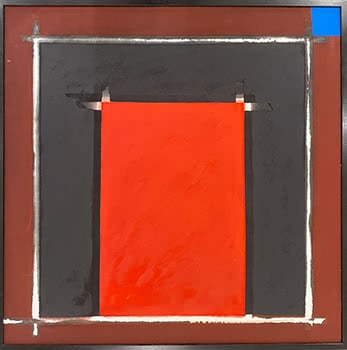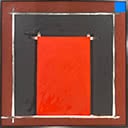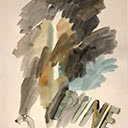Untitled
105.4 x 105.8 cm
est. $50,000 - 75,000
 Relative size
Relative size
Windows are a frequent motif in Ralph Hotere's work, carrying in their representation symbolic associations of illumination and hope. In 1997, the exhibition Out the Black Window curated by Gregory O'Brien for the City Gallery, toured nationally. With its focus on words and poetry in his art, it may have been the catalyst for Hotere creating this work as a return to pure painting. With its large white-framed black and small blue square set within a rust-coloured field, set off by the overlay of a bright red vertically-placed rectangle, this work appears like a series of windows with no transparency. Rather than offering a window on the world, it is a post-painterly abstraction: an exercise in establishing colour relationships, and the disruption of symmetry, without words.
Ralph Hotere (Te Aupōuri and Te Rarawa) was born in Mitimiti, in the Hokianga, and studied at the Dunedin School of Art, becoming one of Gordon Tovey's chosen Education Department arts advisors in the Bay of Islands. In 1961, a New Zealand Art Societies Fellowship supported his study at the Central School of Art and Design in London and subsequent travel in France and Europe, before he returned to New Zealand in 1965. His overseas travel coincided with the ascendancy of Abstract Expressionism, and in particular, Colour Field painting which was characterised by large areas of stained canvas, where paint was applied to unprimed canvas to create the kinds of areas of flat saturated colour seen in this work.
Awarded the Frances Hodgkins Fellowship in 1969, he returned to Dunedin, eventually building a studio at Observation Point overlooking Port Chalmers (inscribed as the location for this work) before Port Otago's bisection of the hill to provide more land for logs to be stored necessitated his move to Harbour Terrace in Carey's Bay. His appreciation of the coastal environment and conservationist desire to protect it provided inspiration for much of his later work.




